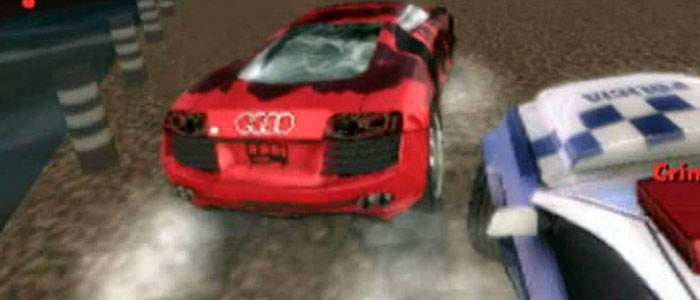Nintendo’s motion-controlled console was built with racing games in mind. OK that may be an overstatement but think about this. When you play games with family and friends who are non-gamers, and you are partaking in racing endeavors what is the first thing a non-gamer will do? Tilt the controller left and right to steer correct? The Wii remote has finally allowed people to do just that to control their gaming experience, and I for one applaud Nintendo for this innovation. This brings me to the latest racing effort for the console Speed Zone. At first glance it appears to be a futuristic racer that will push the limits of speed and physics, but after careful examination what we end up with is an updated version of the classic Rush series with motion control.
The single player experience is broken down into three modes, two of which are actually enjoyable while the third is just downright frustrating. The traditional racing mode is the culprit here as the mixture of unforgiving AI and touchy controls create a frustrating experience. I raced nearly every track, with almost every variation of car and still ended up in last place each time. It is one thing to create a game that becomes progressively more challenging; it is another to never let you win. The solo mode is a bit more enjoyable simple because it bases your performance on various tasks such as staying above a specific speed for a set amount of time. This gives you a chance to become more familiar with the controls, thus creating a more enjoyable experience.
The final and most enjoyable mode is called battle, and as you can imagine it is a futuristic demolition derby complete with weapons and insane arenas. This is where I spent the bulk of my time with the game, and it reminds me of the battle mode found in the Dreamcast versions of the aforementioned Rush series. These modes make up the single player experience alongside some upgrade mechanics and a crude menu system. The multi-player is innovative, if not a bit sloppy.
You can play up to eight players on the same screen. This is made possible by using either four Wii remotes and four nunchuks, or four remotes and four Gamecube controllers. The idea of having eight people playing the game on the same screen is about as much fun in practice as it sounds. No one can keep track of what is going on, and it continues to enforce the idea that the Wii really needs better online so developers can implement it instead of having to implement crude mechanics such as these.
One of the biggest hooks to the game though is the sense of speed. When I received my copy I also received a letter expressing the need to play in HD with the cables connected directly to the TV and not through a third party receiver. After my first ten or so races I was beginning to wonder where that sense of speed would come into play. The game moves at a smooth pace frame rate wise, but a real sense of moving as fast as the game clocks itself is non-existent. Games like Wipeout and F-Zero have defined what it means to blast through a track so fast you are not able to comprehend half of the detail in the environment, and in comparison Speed Zone moves at the pace of a snail.
Now don’t get me wrong, so far I seem overly down on the title, but in all honesty it can be enjoyable. I am a huge advocate of Rush (better known as San Francisco Rush) from the arcade. The physics and track design were what hooked me into that series. Speed Zone feels more applicable to that series as opposed to the futuristic speed racers of the present. Mastering the physics of cornering and upgrading the proper items on your car to achieve maximum control is a must. You will also likely have to tweak the sensitivity of the turning to better suit your play style, as the default feels just a bit too touchy for the most part.
One area where Speed Zone excels when compared to other Wii titles though is the presentation and visuals. You have heard me gripe time and time again about a lack of widescreen and support for 480p when playing on an HDTV, well Speed Zone supports both; exceptionally. The game runs at a rock solid frame rate, and manages to deliver some truly interesting track design to boot. The only thing I feel is lacking is the car design. Everything else looks and feels great. The sound on the other hand is a mixture of generic tunes and bland sound effects. The focus in presentation was surely spent on making the game run as smoothly as it does.
Speed Zone is not a terrible game as much as it is one that seems to try too hard to impress. The visuals are extremely solid when compared to other titles on the console, but the sense of speed just feels lacking. Controls are also a bit too complicated and touchy for simple pick up and play, and when your console is defined by that scenario, it tends to hurt your product. If you enjoyed the Rush titles in the arcade or on Dreamcast or N64 this is a nice throwback to that, but those looking for an adrenaline-filled speed racer, you are better off checking out F-Zero for the Gamecube (or virtual console), or Wipeout on one of Sony’s consoles.
